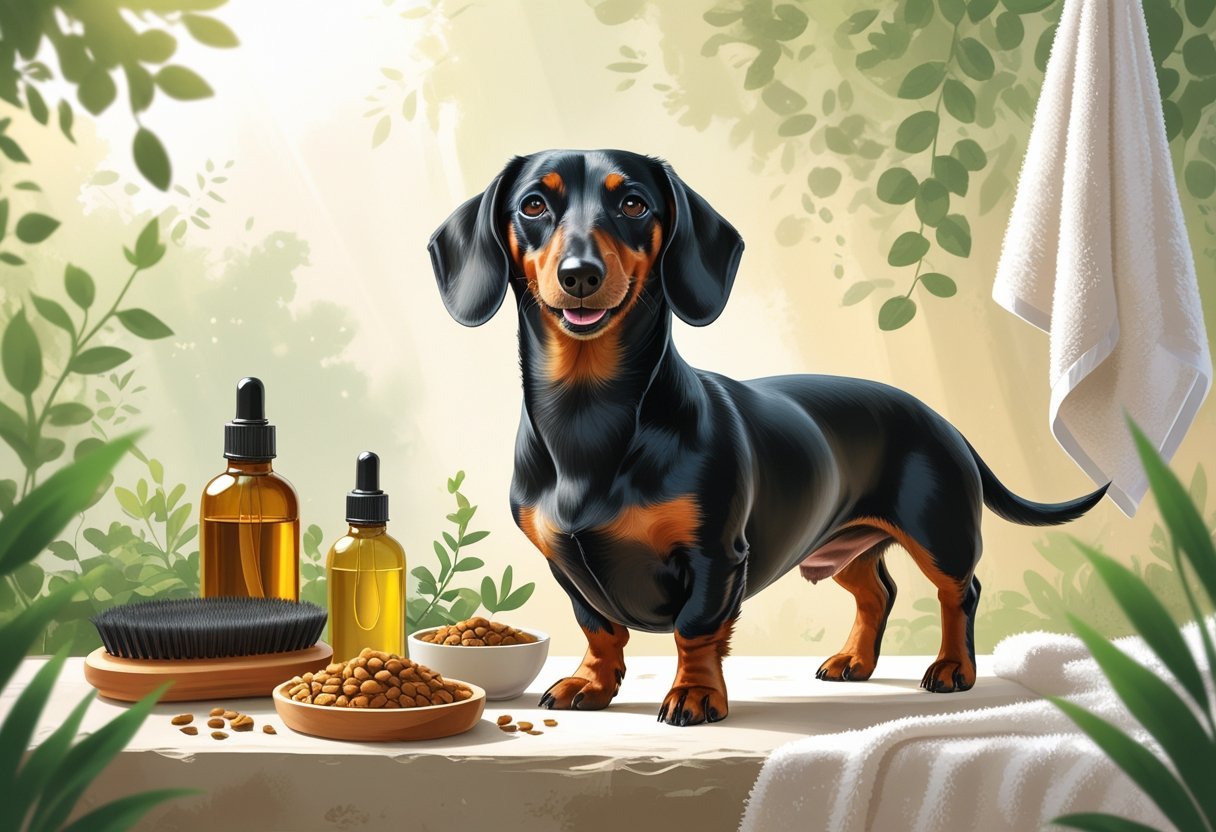Caring for your Dachshund’s skin and coat matters for their comfort and health 🐾. Proper dachshund skin and coat care is essential for keeping your dog healthy 🌟. Regular grooming, good nutrition, and the right products keep your Doxie’s coat shiny ✨ and their skin happy 😊.
Many Dachshunds have sensitive skin 🐶. A solid care routine can help prevent dryness, itching, and a bunch of annoying problems 🌿.
Of course, you want your Dachshund to look and feel great 💕. Even simple tweaks to their daily routine make a big difference in their well-being 🌞.
Keeping their coat clean and healthy usually means fewer vet visits for skin issues 🩺.
Key Takeaways 📝
- Daily care helps prevent common skin and coat problems. 🌟
- Nutrition plays a big role in your Doxie’s coat health. 🥗
- Use safe products and know when to ask a vet for advice. 🐾
🐾 Free Dachshund Care Guide
Download our free checklist to ensure your Dachshund stays happy, healthy, and well-loved!
Get Your Free Guide 🐶Understanding Dachshund Skin & Coat Health
Dachshunds have unique skin and coat traits that need special care 🐾. Knowing their needs and common challenges helps you keep them in good shape 🌟.
Dachshund Skin Types 🐶
Dachshunds often have sensitive skin 💧. Most have normal or dry skin, but some get oily patches.
Dry skin shows up as flakiness or itching 🌿. Oily skin can look greasy or feel sticky.
Watch for redness, bumps, or bald spots 👀. If your dog scratches more than usual, something might be up.
Check their skin often 🔍. Gently part the fur and look for dryness, redness, or any sores.
Clean, smooth skin usually means your Doxie’s doing well ✨.
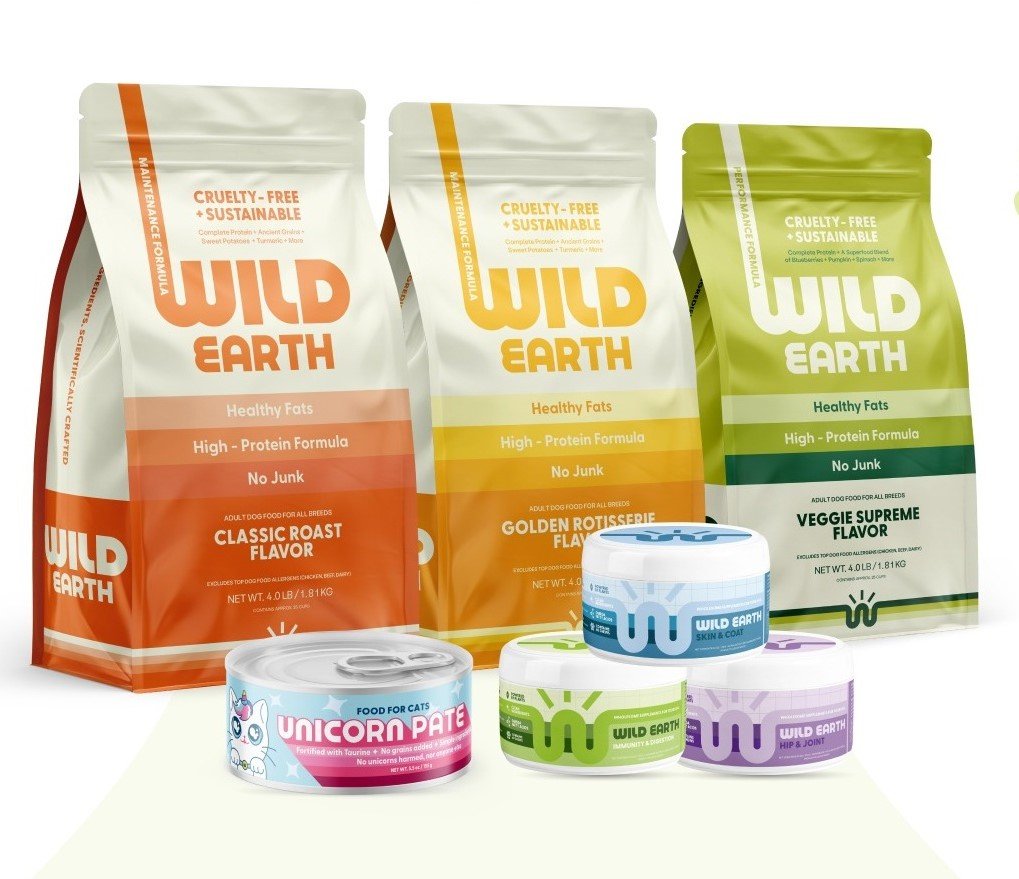
🥗 Wild Earth Complete Protein Food – Clean Nutrition for Skin & Coat
Complete, plant-based recipe that supports moisture balance and a healthy shine for sensitive Dachshunds.
- Gentle, consistent nutrition to help reduce dryness and itchiness 🌿
- High-quality protein supports strong hair growth and healthy skin ✨
- Easy routine upgrade—pairs well with regular grooming and hydration 🐾
Common Coat Characteristics 🐕
Dachshunds come in three main coat types: smooth, longhaired, and wirehaired 🧴. Each type needs its own grooming routine.
- Smooth-coated Dachshunds have short, shiny fur and need weekly brushing 🪮.
- Longhaired Dachshunds have soft, wavy hair that tangles easily and need brushing several times a week 🌸.
- Wirehaired Dachshunds have a rough, thick coat and need hand-stripping or special grooming every few months ✂️.
Some coats pick up dirt or tangle more easily 🌿. Regular care helps prevent mats and keeps them looking shiny 🌞.
Factors Affecting Skin and Coat Condition 📝
Several things can change your Dachshund’s skin and coat health 🐾.
- Diet: A balanced diet with enough omega-3 and omega-6 fatty acids supports healthy skin and a shiny coat. 🥗
- Allergies: Environmental or food allergies can cause itching, redness, or rashes. 🌼
- Parasites: Fleas, ticks, and mites can irritate skin and lead to hair loss or infection. 🐜
- Bathing: Bathing too often or using harsh shampoos dries out skin and makes the coat dull. 🚿
Weather, stress, and health problems matter too 🌦️. Regular grooming, good food, and routine vet visits help keep your Dachshund’s skin and coat in top shape 🩺.
Key Causes of Skin and Coat Issues in Dachshunds
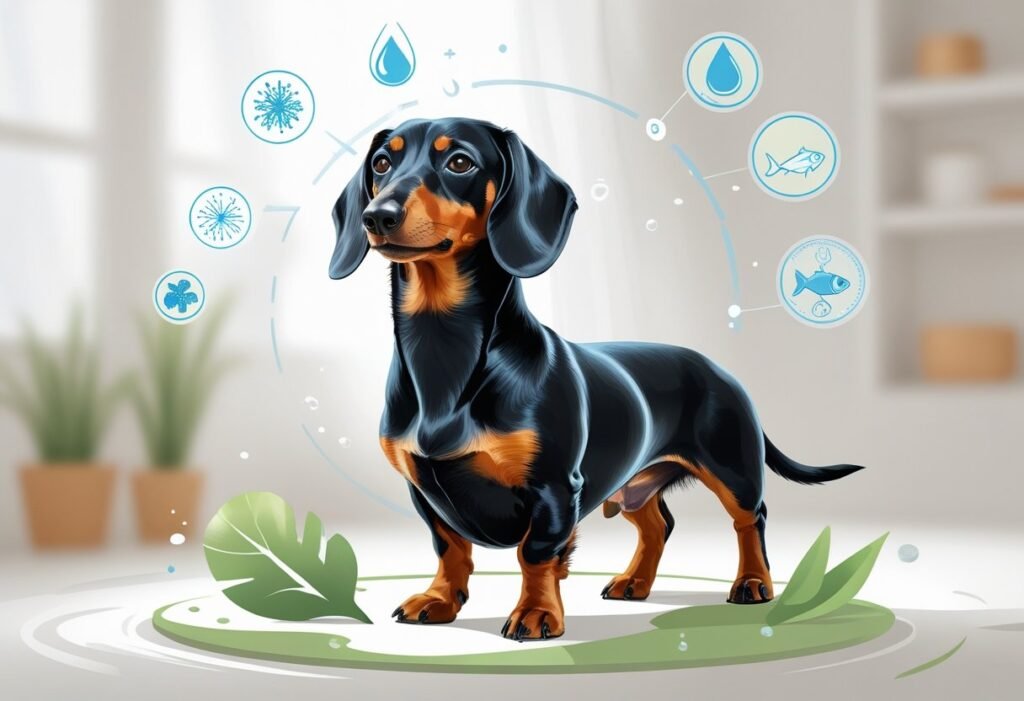
Dachshund skin and coat issues often have clear causes 🐾. Genetics, environment, and allergies all play a part 🌿.
Genetic Predispositions 🧬
Dachshunds are prone to some inherited skin and coat conditions 🐶. Pattern baldness, especially on the ears, chest, or belly, shows up in some lines.
This type of hair loss comes from genetics, not disease or bad care ⚠️. Dachshunds with dilute coat colors (like blue or fawn) can get Color Dilution Alopecia (CDA).
CDA leads to thin hair, bald patches, and sometimes flaky or itchy skin ❗. Some autoimmune skin diseases also pop up more often in Dachshunds than in other breeds.
These problems may cause rashes, inflamed skin, or scaly spots 🔍. If you’re getting a Dachshund, ask the breeder about any known skin or coat issues in the family line.
Some problems, like pattern baldness, don’t have a cure but aren’t dangerous 💡. Knowing what to expect helps you give your pet the best care 🐾.
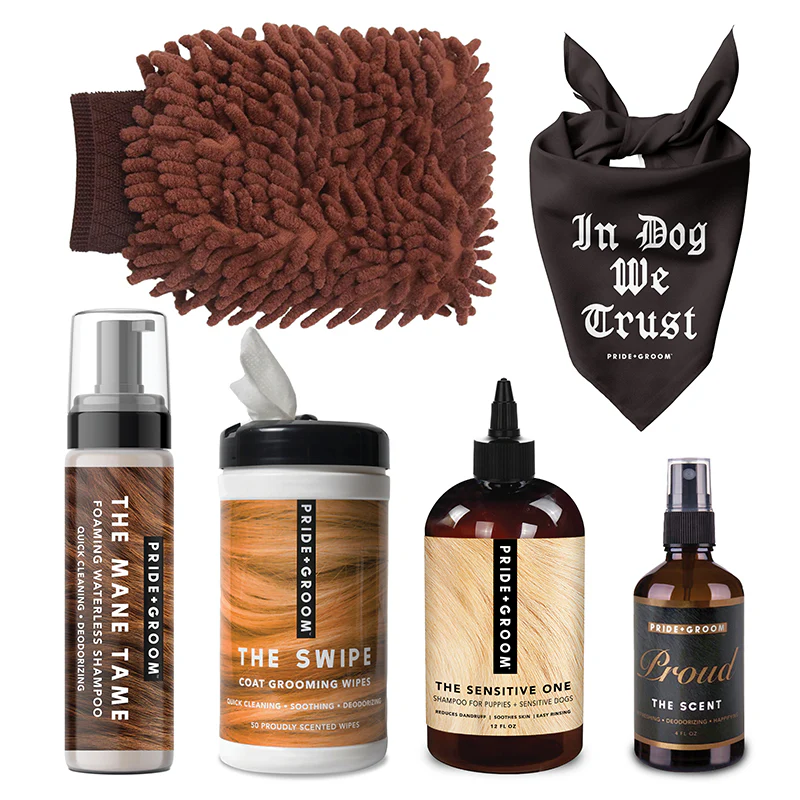
🧴 Pride + Groom Grooming Tools Kit – Gentle Tools, Healthier Shine
Soft, Dachshund-friendly tools that detangle without scratching, distribute natural oils, and keep skin calm.
- Reduces tangles and matting while protecting sensitive skin ✂️
- Helps spread natural oils for a smooth, glossy coat ✨
- Comfortable daily use to minimize shedding and irritation 🐾
Environmental Triggers 🌎
Your Dachshund’s environment affects their skin and coat health 🌦️. Dry air from heating or AC can lead to itchy, flaky skin.
Bathing with the wrong shampoo strips natural oils and makes skin dry 🚿. Walking or playing in areas with pollen, dust, or grass chemicals can trigger irritation 🌼.
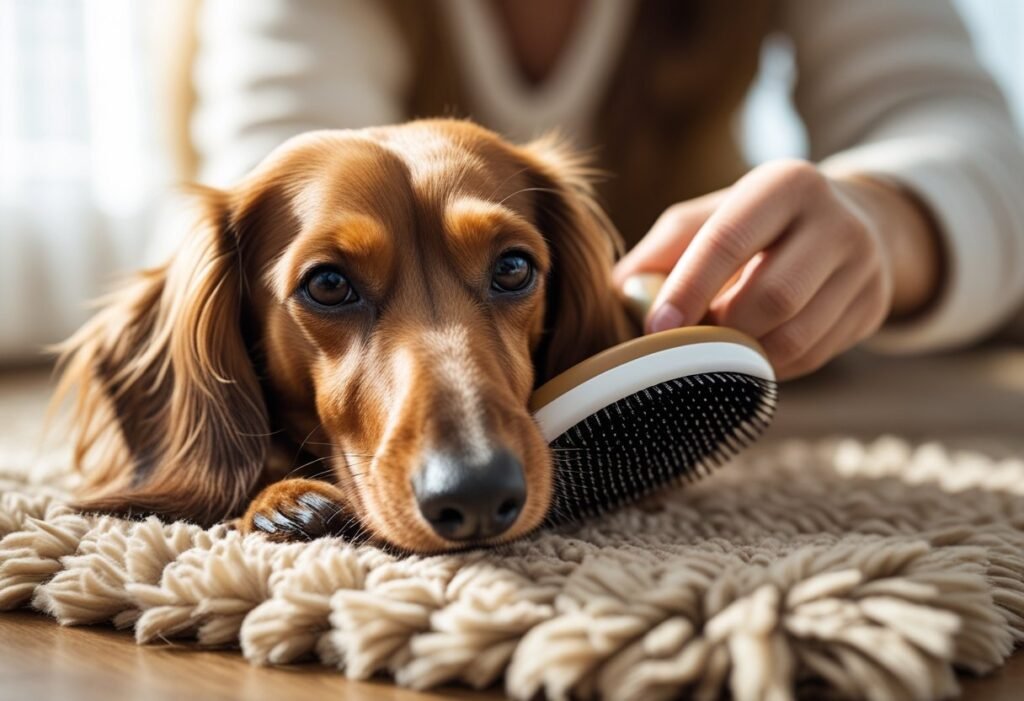
Fleas, ticks, and mites are another worry 🐜. Even a few flea bites can cause serious itching or infections.
If your Dachshund goes outside a lot, keep up with parasite control ✅. Changes at home, like new cleaning products, sometimes cause sudden skin problems too.
If your pet has skin or coat issues, think about what’s changed lately at home or outside 🏡.
Allergies and Sensitivities 🌸
Allergies cause a lot of Dachshund skin and coat trouble ⚠️. Foods like beef, chicken, or certain grains are common culprits.
Signs of food allergies include itching, constant licking, or red patches ❗. Environmental allergies—pollen, grass, mold, or dust mites—may cause seasonal itching or ongoing skin problems.
Look for redness between the toes, ear infections, or non-stop scratching 👀. Dachshunds can also get contact allergies from shampoos, detergents, synthetic fabrics, or even some collars.
These cause irritation or bald spots in certain areas 🐾. Key signs of allergies include:
- Excessive scratching or licking 🌀
- Hair loss in certain spots 🐕
- Frequent ear infections 🩺
- Red or inflamed skin 🔴
If you suspect allergies, your vet can help you find the triggers and suggest changes, meds, or special grooming routines 💊.
Daily Grooming Routines for a Shiny Doxie
A healthy, shiny Dachshund coat starts with daily care 🐾. Regular grooming removes dirt and spreads natural oils ✨.
It really helps keep skin problems at bay 🌿.
Brushing Techniques for Different Coats 🪮
Dachshunds have three coat types: smooth, long-haired, and wire-haired 🐕. Each needs a different brushing method.
For smooth coats, grab a soft-bristle brush or grooming mitt 🧴. Brush gently every day to get rid of loose hair and dirt.
This boosts shine by spreading your dog’s natural oils 🌟. For long-haired Dachshunds, use a slicker brush and a wide-tooth comb.
Brush in layers, starting from the legs and working up 🐾. Pay extra attention behind the ears and under the legs, where tangles and mats love to hide.
Wire-haired Doxies need a slicker brush and a stripping tool ✂️. Brush two or three times a week and use the stripping tool as needed to pull out dead hair.
This keeps their coat healthy and less itchy 😊.

🍽️ ChefPaw Food Maker
- Balanced fresh meals support healthy skin and a shiny coat ✨
- Control ingredients for sensitivities and allergies 🌿
- Easy batch prep keeps feeding routines consistent 📅

⏱️ Petlibro Auto Feeder
- Scheduled portions help reduce overeating and dull coat 🐾
- Consistent feeding supports digestion and nutrient absorption 🌟
- Pairs well with fresh diets for steady energy and shine ⚡
Recommended Grooming Tools 🛠️
The right tools make a big difference for your Dachshund’s skin and coat 🌟. Here’s a quick table to show which tools work best for each coat:
| Coat Type | Main Brush Type | Extra Tools |
|---|---|---|
| Smooth | Soft-bristle | Grooming mitt |
| Long-haired | Slicker | Wide-tooth comb |
| Wire-haired | Slicker | Hand stripping tool |
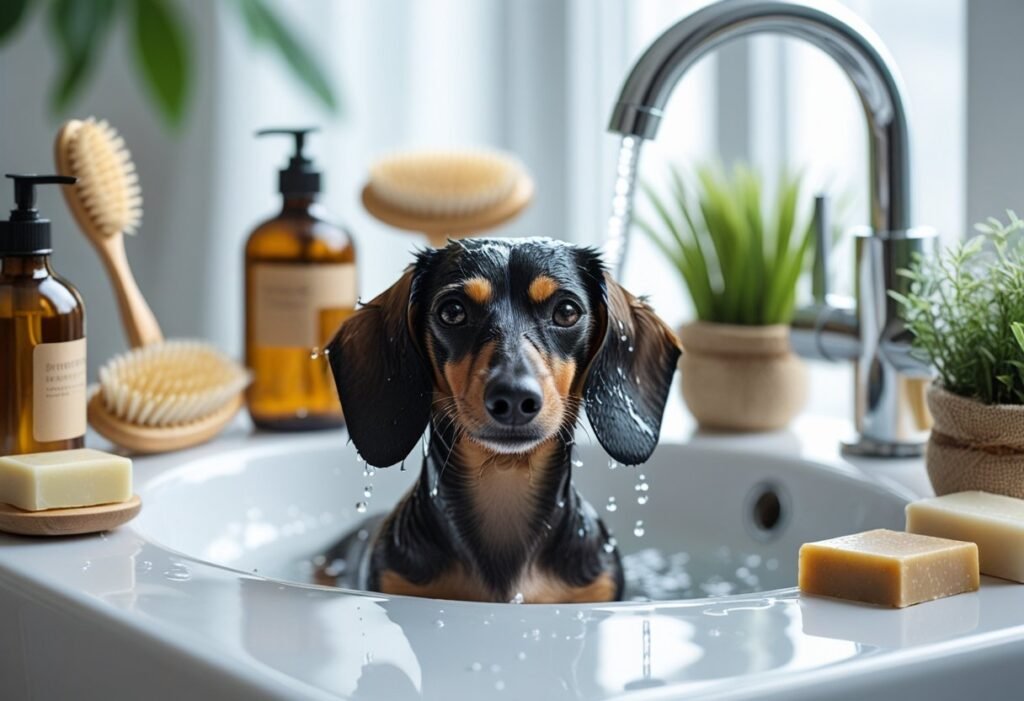
A stainless steel comb helps with tangles on long and wire-haired Doxies 🪮. Always use gentle tools so you don’t scratch their sensitive skin 💕.
Tip: Wipe your dog with a damp, soft cloth to remove dust and add some extra shine ✨.
Bathing Best Practices 🚿
Bathe your Dachshund only when needed—usually every 4 to 8 weeks 🗓️. Bathing too often dries out the skin and dulls the coat.
Pick a mild, dog-safe shampoo 🧴. Harsh or heavily scented products can irritate your dog’s skin.
Rinse really well, since leftover soap can make skin itchy ❗. Dry your dog with a soft towel and keep them warm until they’re totally dry 🛏️.
If your Doxie’s coat seems dull or greasy, ask your vet to check for skin issues or recommend a special shampoo 🩺.
Dachshund Dry Skin: Prevention and Remedies
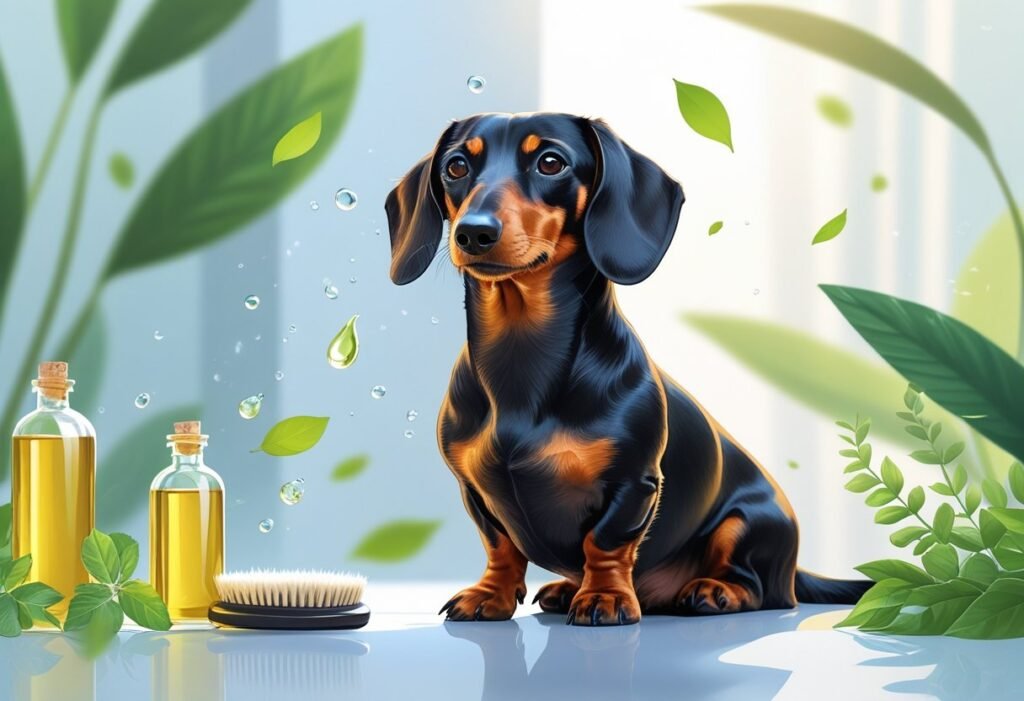
Dry skin is pretty common in Dachshunds, especially in colder months or after too many baths ❄️. Taking care of dryness quickly keeps your dog comfortable and their coat looking good 🐾.
Recognizing Signs of Dry Skin 👀
Dry skin in Dachshunds often shows as flaky patches, dandruff, or a dull, rough coat 🌿. You might notice your dog scratching more or licking certain spots 🐕.
Other signs are redness, small scabs, or a musty smell ⚠️. If your Dachshund bites their paws or rubs against the furniture, dry skin could be to blame 🛋️.
Check their skin during grooming 🔍. Look for small white flakes or spots where the fur looks thin.
If the skin is red or inflamed, it’s probably time to see a vet 🩺.

🛏️ Majestic Pet Orthopedic Bed
- Memory foam comfort reduces pressure points and hot spots 💤
- Better rest helps skin recover and lowers stress-scratching 🌙
- Washable cover keeps the sleep surface clean and coat-friendly 🧼
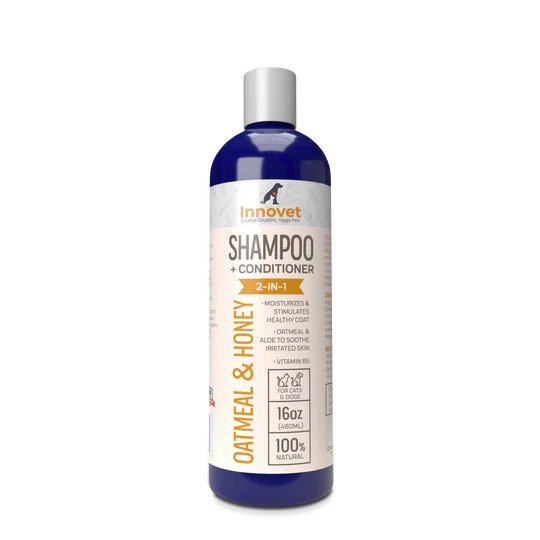
🧴 Innovet Oatmeal & Honey Shampoo
- Oatmeal and honey soothe dry, itchy skin without irritation 🌾
- Moisturizing wash supports a soft, glossy coat ✨
- Mild formula works well for regular grooming routines 🌸
Effective Home Remedies 🏡
Managing mild dry skin at home doesn’t have to be complicated 💡. Try adding a humidifier in rooms where your dog hangs out, especially during winter 🌬️.
Regular brushing spreads natural oils over their coat ✨. That little bit of extra attention can really help keep moisture in.
Omega-3 fatty acids from fish oil support skin health 🥥. You might add a vet-approved fish oil supplement to your dog’s food 🍲.
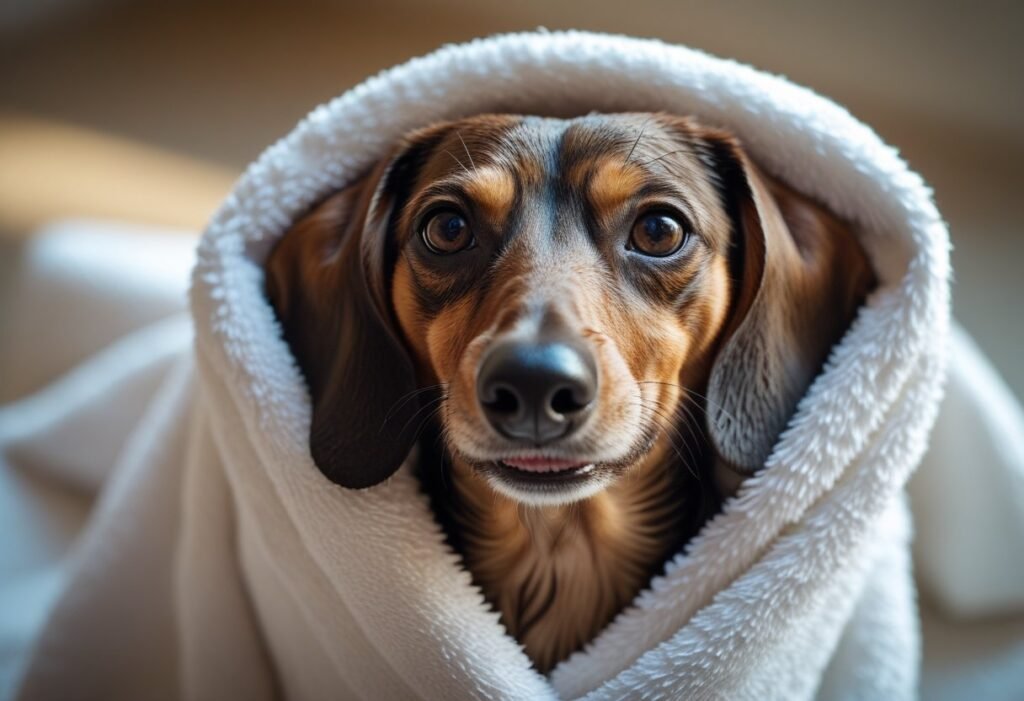
🎉 Grab your free Dachshund care checklist!
Don’t over-bathe your Dachshund, since too many baths strip away their natural oils and make dryness worse 🚿. It’s easy to think more baths equal more cleanliness, but it often backfires ⚠️.
Oatmeal baths can soothe itchy, dry skin 🌾. Use plain, unscented oatmeal and cool water—nothing fancy or perfumed.
After the bath, pat your dog dry instead of rubbing 🧴. Keep your dog’s water bowl full, since hydration matters just as much as anything else 💧.
Choosing the Right Moisturizing Products 🧴
Pick products made specifically for dogs with sensitive or dry skin 🌸. Look for shampoos with gentle, moisturizing ingredients like aloe vera, oatmeal, or coconut oil.
Steer clear of anything with parabens, dyes, or heavy perfumes 🚫. Those can irritate the skin, and no one wants that.
Moisturizing sprays and conditioners for dogs add extra hydration between baths 🌟. Here’s a quick table to help choose:
| Product Type | Key Ingredient | Note |
|---|---|---|
| Shampoo | Oatmeal, Aloe Vera | Gentle, non-irritating |
| Leave-in Conditioner | Coconut Oil | Adds lasting moisture |
| Spray | Vitamin E | Use between baths |
Always test a small area first to check for any reaction 🧪. If you’re unsure, just ask your vet for product recommendations 🩺.
Nutrition and Supplements for Optimal Skin and Coat
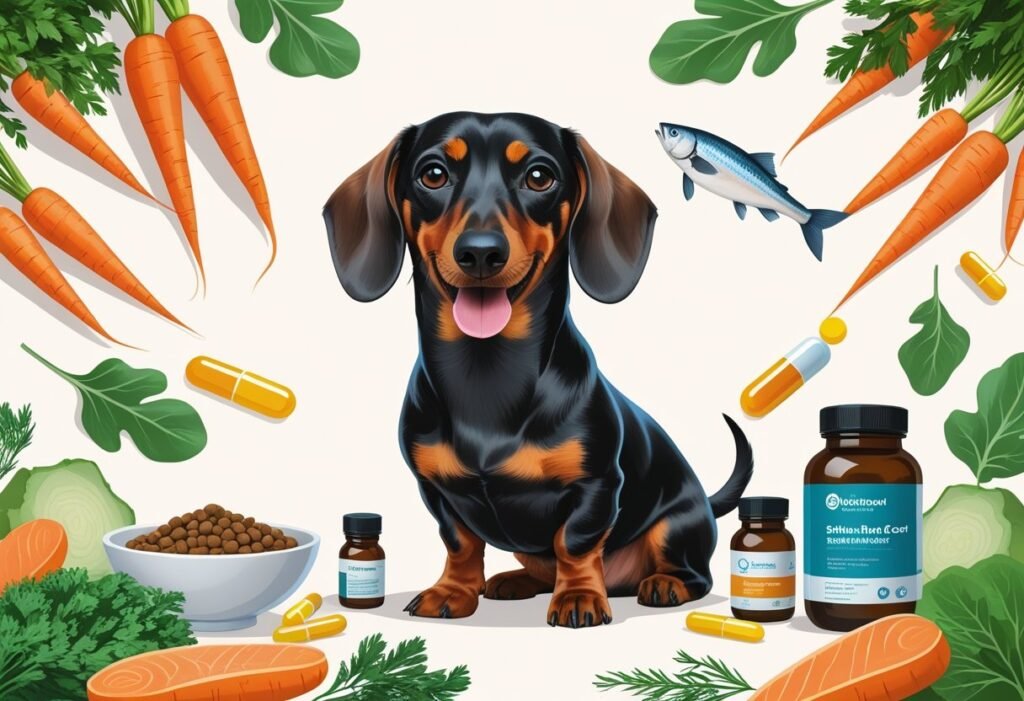
Your Dachshund’s skin and coat health really depends on what they eat 🍲. The right foods, supplements, and keeping your dog hydrated all help your Doxie have a shiny, soft coat and healthy skin ✨.
Essential Nutrients for Dachshunds 🥗
Dachshunds need a good balance of nutrients for healthy skin and a shiny coat 🌟. Omega-3 and Omega-6 fatty acids are especially important.
These fats help cut down on dryness and itching 🌿. You’ll find them in fish oil, flaxseed, and some dog foods labeled for skin and coat health.
Protein matters, too, since fur is mostly protein 💪. Choose foods where chicken, fish, or eggs are the main ingredient.
Vitamin E and zinc help soothe and protect the skin 🌸. Vitamin A supports cell growth, making hair stronger.
Feed a high-quality, balanced dog food made for small breeds 🐾. If you cook at home, check with your vet to make sure your Dachshund gets all these nutrients 🩺.

📹 Petcube Cam 360
- 24/7 live view to spot scratching or over-licking early 🐾
- Two-way talk to calm anxious moments that trigger skin flare-ups 🧘
- Motion and sound alerts so you don’t miss post-bath irritation checks 🔔
📍 Tractive GPS Tracker
- Real-time location to avoid areas with grass chemicals or allergens 🌿
- Safe zones with alerts keep adventures skin-friendly and stress-free 🛡️
- Activity tracking helps you hit healthy routines for a glossy coat ✨
Recommended Supplements 💊
If your Dachshund’s food doesn’t quite cover everything, supplements can help 🌟. Here are some common ones:
- Fish oil (Omega-3) 🐟
- Salmon oil 🐠
- Coconut oil 🥥
- Biotin 🌿
- Zinc ⚡

Fish oil and salmon oil add healthy fats for a shinier coat and less flaky skin ✨. Biotin, a B vitamin, can help with hair loss. Zinc supports skin health and helps with healing 💡.
Always talk to your vet before starting supplements 🩺. Too much of anything—even vitamins—can do more harm than good ⚠️. Read the dosing instructions and stick to them 📖.
Hydration and Its Impact 💧
Water is just as important as food for a healthy coat 🚰. If your Dachshund doesn’t drink enough, their skin can get dry and itchy.
Dehydration also makes the coat look dull or thin 🌞. Make sure your dog always has fresh water.
Clean the bowl daily and refill it often, especially when it’s hot 🔥. Canned dog food has more moisture than dry kibble, so it can help with hydration.
Watch how much your Dachshund drinks, especially in warm weather or after exercise 🐾. Good hydration means softer skin and a glossier coat ✨.
Professional Care and When to Seek Help
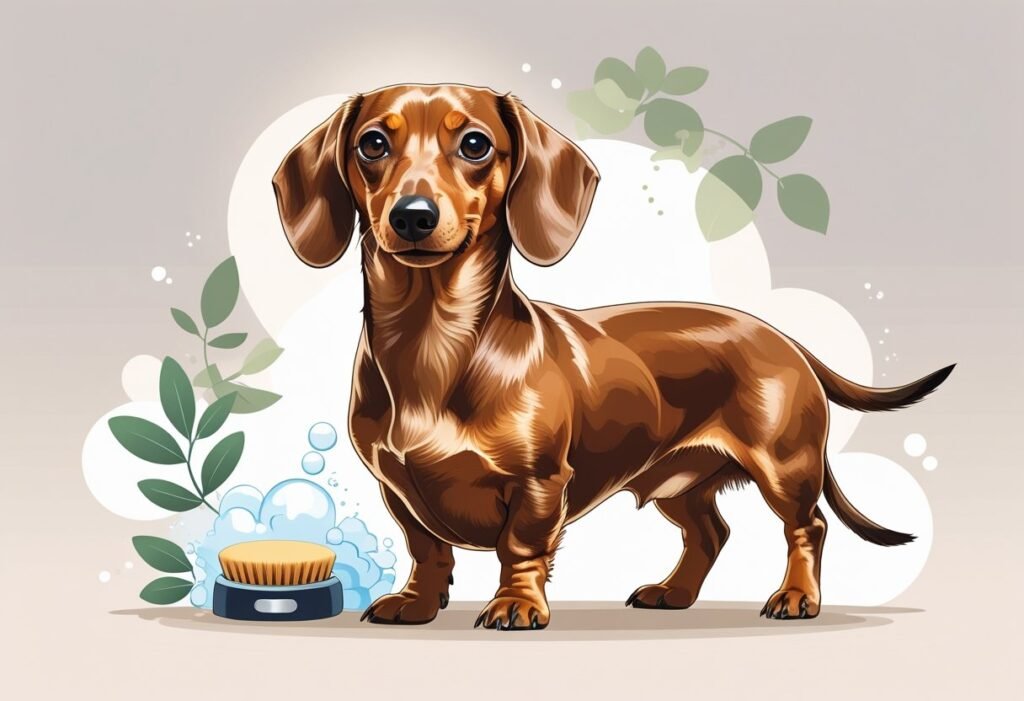
Sometimes, home grooming just isn’t enough ✂️. Certain issues need professional attention to keep your Dachshund healthy and comfortable 🐾.
Veterinary Dermatology 🩺
If your Dachshund has skin redness, bald patches, open sores, or won’t stop scratching, a veterinarian with dermatology training can help 👩⚕️. Vets can run tests like skin scrapings, allergy checks, or blood tests to figure out what’s going on 🔍.
Common problems include allergies, infections, mites, or hormonal issues ⚠️. Your vet might prescribe medicines such as antibiotics, antifungals, or special shampoos after a diagnosis 💊.
Watch for symptoms like:
- Red or irritated skin 🔴
- Oozing or scabbing 💧
- Bad odor 👃
- Excessive shedding or hair loss 🐕
- Thickened or flaky skin 🌿
Getting care quickly helps stop little problems from turning into big ones ⏱️. No one wants their dog in pain or at risk for infection 💔.

🧾 The Swiftest Pet Insurance Comparison Tools
- Compare plans that cover allergy tests, dermatology visits, and meds 🩺
- Transparent pricing so you can budget long-term skin care confidently 💡
- Find policies that fit Dachshunds prone to skin sensitivities 🐾

🌿 Zomalka Anxiety Relief Drops
- Gentle calming support to reduce stress scratching and over-grooming 🧘
- Easy liquid dosing; pairs well with a steady grooming routine 🧴
- Helpful for loud events or changes that can trigger itchy flare-ups 🌦️
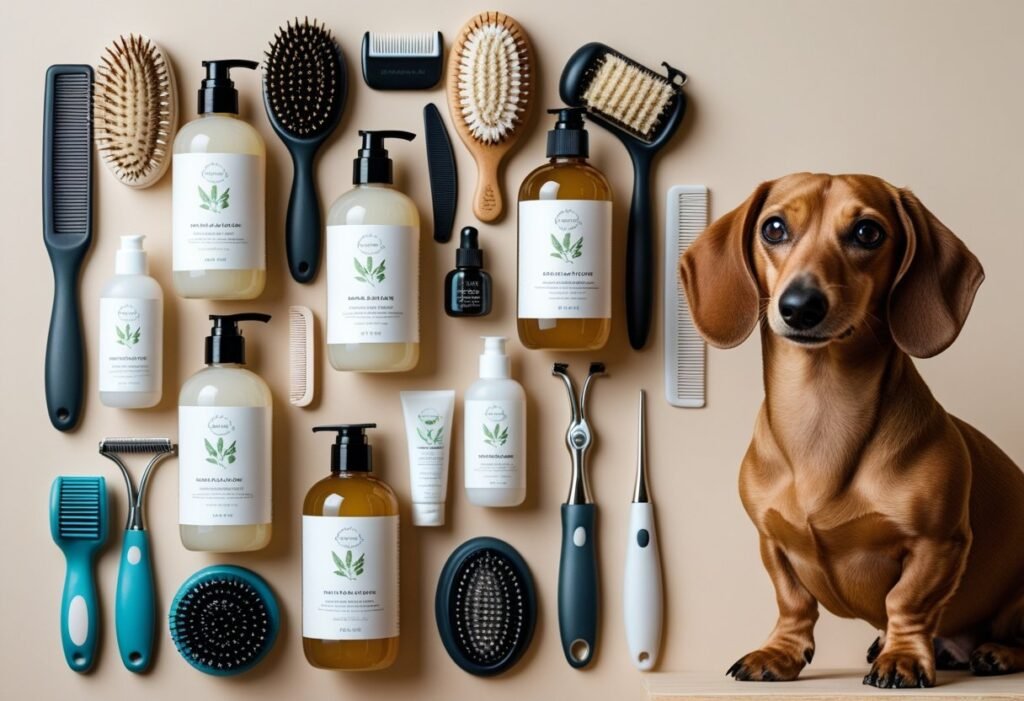
Grooming Services for Specialized Needs 🧴
Professional groomers know how to handle Dachshunds with tricky coats or sensitive skin 🐶. If your dog’s fur tangles or mats easily, or you just can’t keep up, a groomer is a lifesaver 🙌.
Groomers offer:
- Deshedding treatments ✨
- Medicated baths 🚿
- Trimming for long-haired Dachshunds ✂️
- Ear cleaning and nail trims 🐾
They’re also great at spotting early warning signs of skin issues, like unusual lumps or hot spots 👀. Tell your groomer about any past skin concerns so they can use the right products and take extra care 🌸.
Seasonal Skin and Coat Care Tips
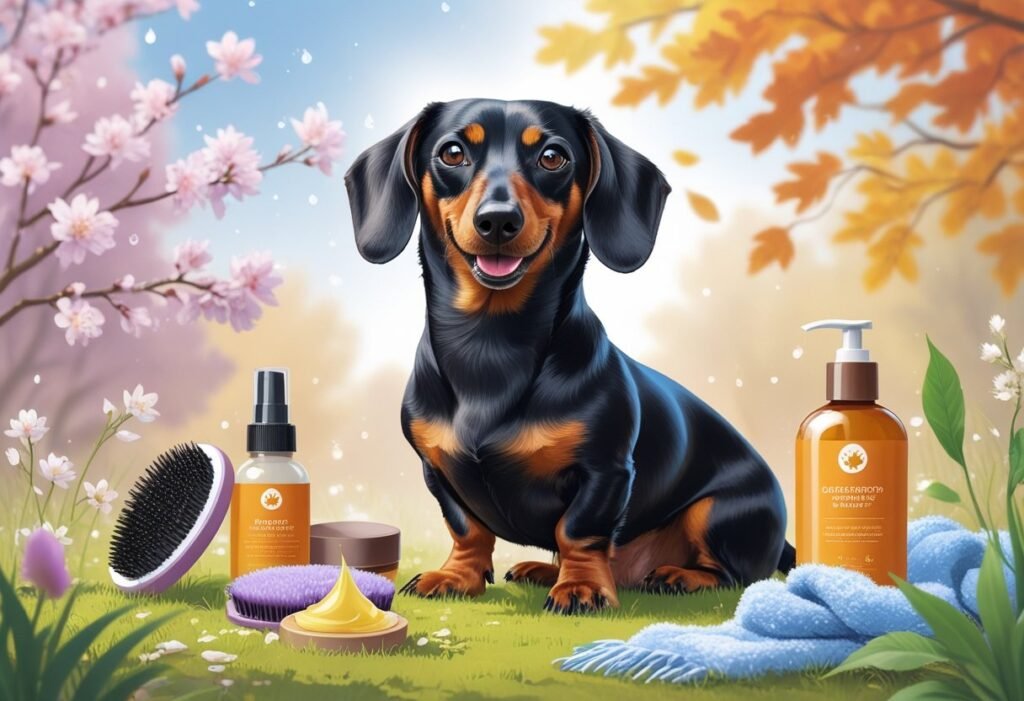
The way you care for your Dachshund’s skin and coat needs to shift with the seasons 🌦️. Temperature changes, humidity, and shedding patterns all play a part in how your Doxie looks and feels 🐾.
Adapting Grooming Routines for Weather 🌡️
Warm months can make your Dachshund’s skin oilier 🌞. Cold weather usually leads to dryness or flakiness ❄️.
In summer, bathe your Doxie a bit more if they get dirty, but don’t overdo it—once every 3 to 4 weeks is usually enough 🚿. Use a mild, moisturizing dog shampoo to protect natural oils 🧴.
When winter air is dry, brush gently three or more times a week 🪮. Brushing helps spread oils and keeps skin from drying out 🌸.
Inside, a humidifier adds moisture to the air if your home gets very dry 🌬️. Skip very hot water at bath time, since that can strip important oils and cause irritation ⚠️.
✨ Healthy Skin & Coat Essentials for a Radiant Doxie 🐾
- 💧 Petlibro Water Fountain — Hydration plays a huge role in healthy skin and coat. This steady-flow fountain keeps your Dachshund’s skin moisturized from within.
- 🍖 Petcube Bites 2 — Reward calm grooming behavior or bath time with healthy treats using this smart dispenser — making coat care stress-free and fun.
- 🪜 Majestic Pet Stairs — Prevent back strain while hopping onto grooming tables or couches. Safe access means less stress and fewer skin flare-ups.
- 🧬 AnimalBiome Gut Health Test Kit — A balanced gut leads to glowing skin and a shiny coat. Discover your Doxie’s microbiome and personalize their nutrition.
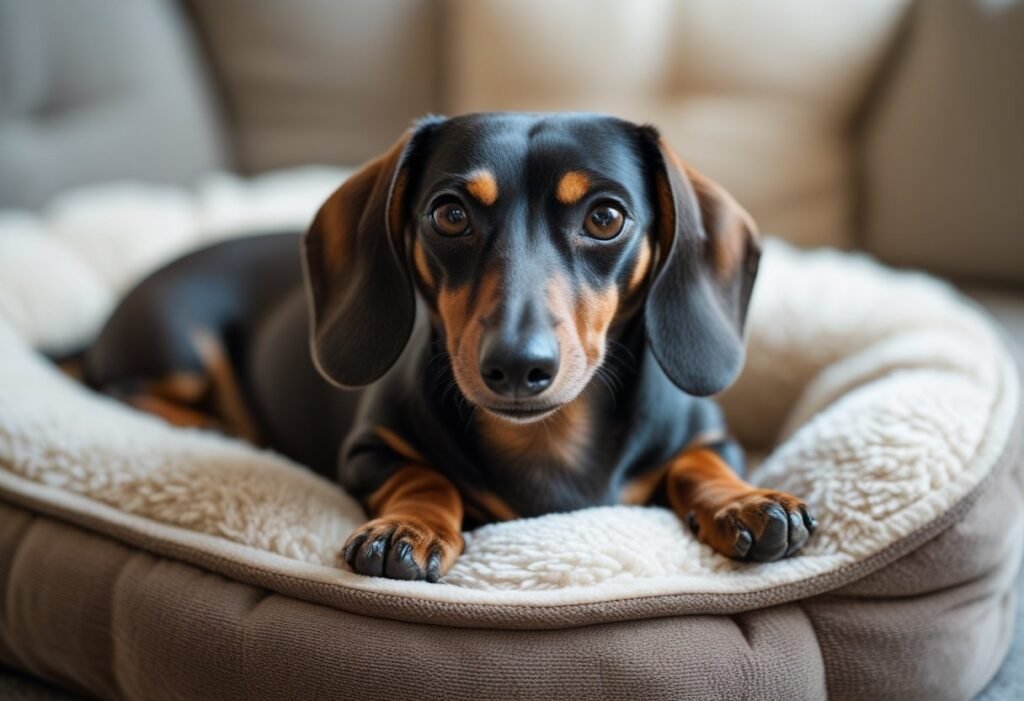
Managing Shedding Throughout the Year 🐕
Dachshunds usually shed more during spring and fall 🍂. Double-coated types need more frequent brushing in these months to remove loose hairs.
A simple bristle or slicker brush works well for most Dachshunds 🪮. Here are some quick tips:
- Short-haired: Brush once a week most of the year, but 2–3 times during shedding season. 🗓️
- Long-haired or wire-haired: Brush three or more times a week year-round. 🌟
Regular grooming keeps shedding hair off your furniture and clothes 🛋️.
If you spot signs of allergies—like chewing or redness—especially when outdoor pollen is high, wipe your dog’s paws and belly with a damp cloth after walks 🌼. Staying on top of this routine helps your Doxie stay comfortable and looking their best, no matter the season ✨.
Safe Products and Ingredients for Dachshunds
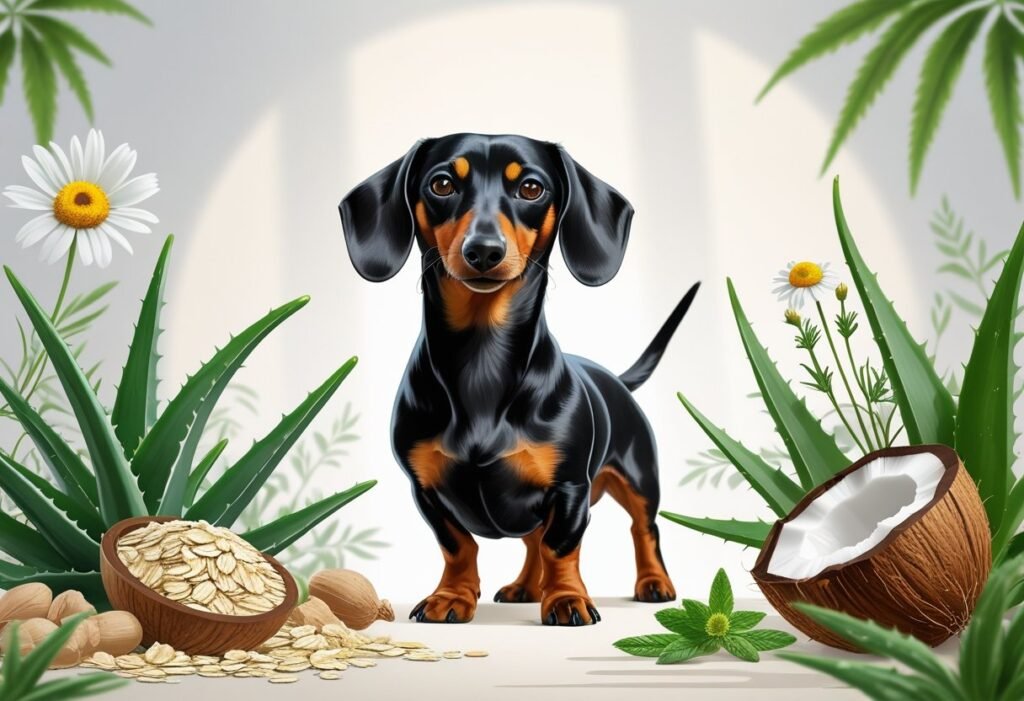
Dachshund skin and coat care really needs gentle, effective products 🐾. Some common ingredients in pet shampoos and conditioners can actually cause irritation or dry skin ⚠️.
Shampoos and Conditioners to Avoid 🚫
Lots of store products promise shiny coats, but not all are safe for Dachshunds ❌. Avoid shampoos and conditioners with:
- Artificial fragrances 🌸
- Parabens 🧪
- Sulfates (like sodium lauryl sulfate or SLS) 💧
- Alcohols 🍂
These ingredients strip natural oils, making skin dry or itchy 🌿. They can even trigger allergies in Dachshunds with sensitive skin 🐕.
Artificial dyes and colors don’t help with cleaning and may cause irritation 🎨. Always check labels before buying grooming products 🛒.
Look for items labeled “hypoallergenic” or “gentle,” but still read the ingredient list to be sure ✅. Human shampoos are usually too harsh for Dachshunds 🚿.
💛 Top Picks for a Healthy, Shiny & Happy Dachshund Coat ✨
- 🎽 Embark Pet Adventure Harness – Walk your Doxie safely and comfortably while preventing friction that can irritate sensitive skin.
- 🧠 Brain Training for Dogs – Keep your Dachshund mentally active to reduce stress-related scratching and promote calm, healthy skin.
- 🫧 King Klean Dog Shampoo – Natural, non-toxic formula that deeply cleans while nourishing your Doxie’s coat for long-lasting shine.
- 🎨 Purr & Mutt Personalized Dachshund Art – Celebrate your Doxie’s glossy coat and loving personality with stunning, custom artwork for your home.
- 👕 Dog is Good Apparel & Gifts – Show off your pride in your Dachshund’s healthy, beautiful coat with stylish, dog-lover-approved apparel.
🐾 Consistent grooming, hydration, and gentle care go a long way — help your Doxie glow with these trusted essentials.
Natural Alternatives for Sensitive Skin 🌱
For Dachshund dry skin, natural ingredients tend to work best 🌟. Here are some safe, soothing options to look for:
- Oatmeal: Calms itching and softens skin 🌾
- Aloe vera: Soothes irritation and adds moisture 🍃
- Coconut oil: Helps moisturize and protect the coat 🥥
These ingredients rarely cause allergic reactions 💡. DIY remedies like an oat bath can help mild itchiness 🛁.
Skip essential oils unless your vet says they’re safe 🚫. Some can harm dogs even in tiny amounts ⚠️. Using gentle, natural products keeps your Dachshund’s coat shiny and healthy without causing irritation ✨.
If you see redness or flakes, stop using that product and ask your vet for advice 🩺. Sometimes, less is more when it comes to sensitive skin 💕.
🐾 Don’t Miss Out!
Download our free Dachshund care guide to keep your furry friend happy and healthy.
Get Your Free Guide 🐶Frequently Asked Questions
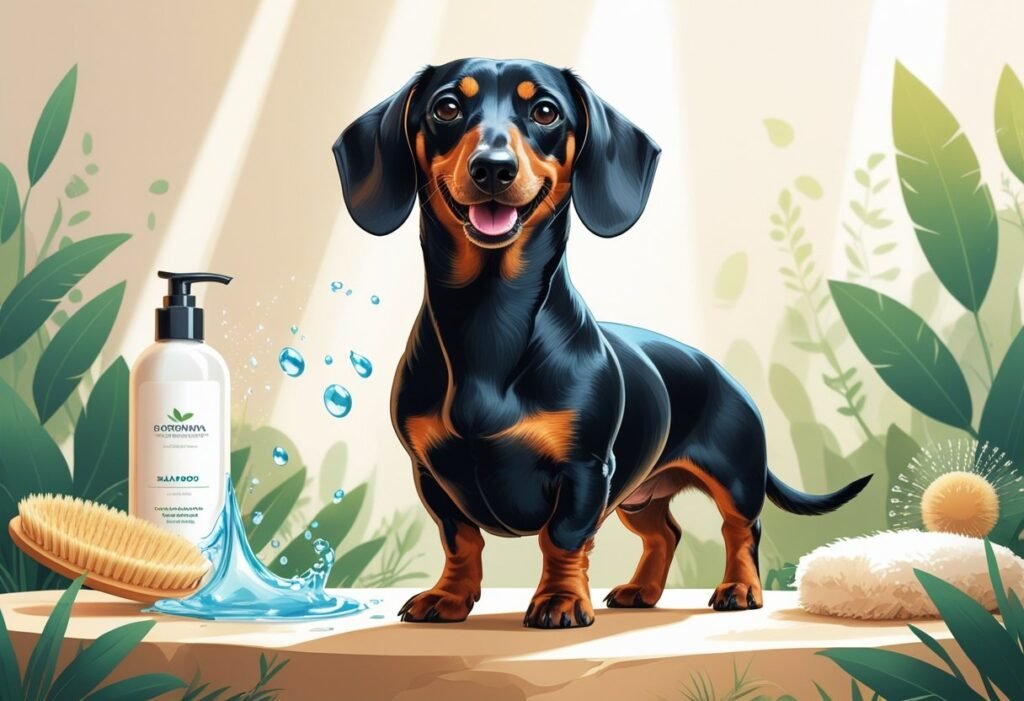
Want your Dachshund’s skin and coat looking their best? You’ll need the right foods, a few smart supplements, and regular grooming 🐾.
Shiny fur usually means your pup’s in good shape ✨. Dull or itchy skin, though, might mean something’s up ⚠️.
What are effective home remedies to enhance the shine of my Dachshund’s coat? 🌿
Try brushing your Dachshund gently a few times a week 🪮. This helps get rid of dirt and spreads natural oils.
Wash your dog with a gentle dog shampoo about once a month 🚿. Rinse well, and don’t forget to dry thoroughly 🛏️.
If you want to go the extra mile, add a little cooked egg or a teaspoon of fish oil to their meals 🍳. It’s a simple trick that often works wonders 🌟.
What are the indicators of an unhealthy Dachshund coat? ❓
Keep an eye out for fur that looks dry, dull, or brittle 🌫️. Bald spots, weird smells, and constant itching are red flags, too 🚩.
Red or irritated skin can mean your dog’s uncomfortable 🔴. If you notice any of this, it’s probably time to call your vet 🩺.
Which dog foods are recommended for promoting a shiny coat in Dachshunds? 🥗
Pick dog foods rich in omega-3 and omega-6 fatty acids 🐟. Salmon, chicken, or lamb formulas usually help keep coats healthy.
Go for trusted brands with whole grains and veggies 🌾. Skip anything with weird artificial stuff—simple is best ✅.
What supplements can improve my Dachshund’s skin and coat health? 💊
Some owners swear by fish oil, coconut oil, or omega fatty acid supplements 🥥. These can really boost skin and coat condition.
Vitamin E and biotin might help with shine and shedding ✨. Still, it’s smart to check with your vet before adding anything new 🩺.
How can baking soda be used for improving a Dachshund’s coat shine? 🧼
Sprinkle a tiny bit of baking soda on your dog’s dry fur, then brush it out 🪮. It’s a quick fix for odor and greasy fur.
Just don’t go overboard—too much can irritate your pup’s skin ⚠️. Moderation is key here 🔑.
What methods can make a Dachshund’s fur soft and shiny? 🌟
Regular brushing helps spread your dog’s natural oils 🐕. That alone can make their fur softer and shinier over time.
Give your Dachshund a bath using a gentle dog shampoo 🚿. Don’t forget to keep their diet balanced, too 🍲.
Healthy treats and clean water matter more than you’d think 💧. And honestly, a calm, low-stress -home does wonders for their coat 🏡.

